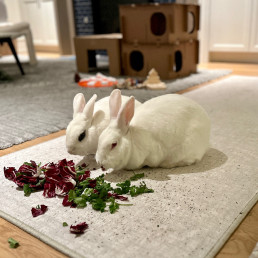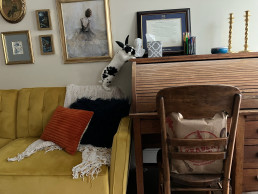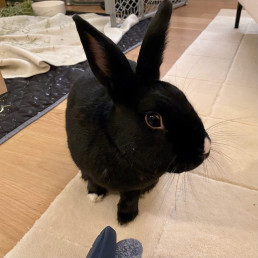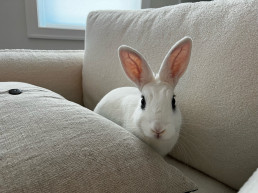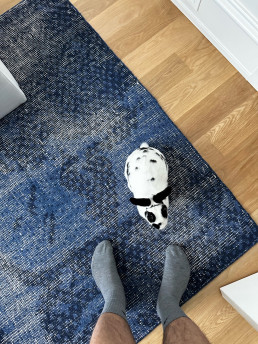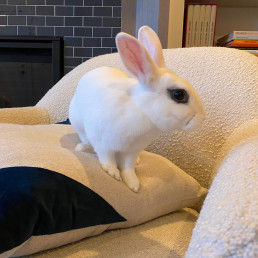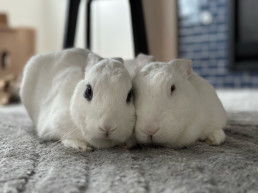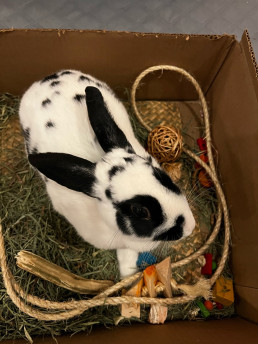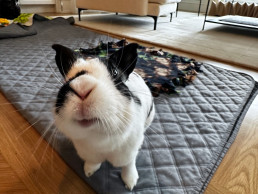Benefits of Scatter Feeding Rabbits
Benefits of Scatter Feeding Rabbits
HRS Chicago encourages rabbit guardians to scatter feed their able bodied rabbits. Some of the benefits of scatter feeding are below:
-
- Encourages Natural Foraging Behavior:
Rabbits, in their natural habitat, spend a significant amount of time foraging for food. Scatter feeding replicates this natural behavior, allowing rabbits to explore and engage in natural foraging activities. This not only fulfills their biological need but also prevents boredom, keeping them mentally stimulated. - Physical Exercise and Mental Stimulation:
Scatter feeding turns mealtime into an interactive experience. As rabbits search for scattered food, they engage in physical exercise, promoting a healthy weight and preventing obesity. The mental stimulation derived from this activity is crucial for their overall well-being, reducing the risk of behavioral issues caused by boredom. Moving around to eat their meals can also help with bunnies who are prone to bladder sludge. - Environmental Enrichment:
Introducing variety into a rabbit’s environment is essential for their mental health. Scatter feeding enables you to scatter food throughout their living space, encouraging exploration and providing a dynamic, enriched environment. This promotes a more active, happy, and fulfilled rabbit. - Enhances Bonding Between Guardian and Rabbit:
Participating in scatter feeding allows for quality bonding time between guardians and their rabbits. As you scatter food, your rabbit associates you with positive experiences, strengthening the human-animal bond. This shared activity fosters trust and companionship, contributing to a happier and more well-adjusted rabbit. - Enhances Bonding Between Rabbits: Foraging and eating together is a bonding activity. In fact, it’s an integral part of the bonding process! Focusing on foraging and eating keeps their mind off of any negative bonding behaviours or fighting. Often during the bonding process, if the bunnies start to act up a bit, you can throw down some of their favorite foods and it will redirect their energy right away.
- Prevents Food Aggression:
In a multi-rabbit household, or even with other pets, scatter feeding can help prevent food-related conflicts. When rabbits forage individually, there’s less competition and stress during mealtime. This reduces the likelihood of food aggression and ensures each rabbit receives an adequate portion without the need for constant supervision. - Prevents Selective Eating:
Rabbits are notorious for selective eating, often leaving behind certain components of their meals. Scatter feeding discourages this behavior, as rabbits are less likely to pick and choose when their food is spread out. This ensures they receive a well-rounded diet, including all essential nutrients. - Fewer Dishes to Wash!
- Encourages Natural Foraging Behavior:
- Additional reading : https://oxbowanimalhealth.com/blog/a-beginners-guide-to-scatter-feeding/
Rabbit Proofing
Why Do Rabbits Chew?
By Katie Boron
There are several different reasons why rabbits chew on things. The most obvious reason is that it is simply a natural behavior for them. Rabbits have teeth that are constantly growing, and chewing can help to prevent them from getting too long. However, chewing can sometimes become excessive.
One reason behind excessive chewing may be boredom. Rabbits that lack enrichment or do not have a rabbit friend to keep them entertained are likely to chew things that they shouldn’t. Another factor that can contribute to boredom is a living space that is too small. Rabbits that have more freedom are less likely to be destructive. Having several different toys can also keep rabbits entertained and distract them from chewing on things, especially if you occasionally swap out old toys for new ones to keep things interesting. Not all rabbits like the same toys and some can be very picky with what they play with, so you may need to try several different toys before finding the right ones. In addition to providing plenty of toys, it is always a great idea to ensure that your rabbit has a companion of its own species. As humans, we cannot provide the same type of companionship or entertainment that another rabbit can.
In some cases, excessive chewing can be a hormonal issue. Rabbits that are not spayed or neutered are likely to engage in undesirable behaviors such as chewing. Getting a rabbit spayed or neutered by a trusted exotic vet can usually lead to a decrease in these behaviors. Below, we’ve listed some things that rabbits are prone to chewing and what you can do to help.
Cables
A lot of rabbits love chewing on phone chargers and other cables found throughout the house. This can be expensive for rabbit guardians as chewed cables will need to be replaced, but more importantly, it is dangerous for rabbits. A rabbit that chews through a cable will get an electrical shock that can cause a variety of injuries, from burns in the mouth to heart damage or even sudden death, depending on how high the voltage is. In some cases, usually with low voltage cables like iphone chargers, rabbits can remain unharmed, but it’s always better to be safe than sorry.
Thankfully, there are ways to prevent your cables from being destroyed. The most popular method used by rabbit guardians is using cord covers. There are several different types of cord covers, and many of them are affordable. Cord covers made of a woven material are a great option for rabbits that like to chew because they are durable and tend not to become damaged by chewing as easily as plastic cord covers.
Baseboards and Furniture
It can turn into a huge problem if your rabbit chews your baseboards, especially if you live in an apartment or a rental property. In rescue, we see so many people returning or surrendering their rabbits for chewing baseboards. If you find yourself in this situation, don’t immediately start looking for a new home for your rabbit - there is always another solution! Instead, try covering your baseboards. Some rabbit guardians line their baseboards C&C grids to prevent chewing. If you don’t like the way that the regular metal grids look, you can purchase transparent plastic grids that will work just as well.
Furniture can be a little bit trickier to protect, but it is definitely possible to minimize the damage that your rabbits can do. If you have a rabbit that likes to rip up couches, you can use couch covers. These come in a variety of different patterns and styles and help protect the couch’s fabric.
Another option would be to supervise your rabbit’s free roam time or block off rooms that contain furniture your rabbits enjoy chewing on. If you have the space in your house, you could also give your rabbits their very own room and remove furniture that is frequently chewed.
Blankets and Rugs
Almost everyone who has rabbits has a collection of tattered blankets that their rabbits decided to eat instead of snuggle with. While you can’t do much to stop this, you can make sure that you are providing your rabbits with safe materials if they are prone to ingesting fabric. Generally, fleece blankets are a safe option. Due to its short fibers, fleece is unlikely to cause a blockage when ingested. As for rugs, buying rugs with shorter fibers can make it more difficult for rabbits to pull the fibers out. In my personal experience, I have found that my rabbits like to tear up rugs that have loops or long fibers.
House Plants
The majority of house plants are not rabbit safe, but if they are within reach, rabbits will usually try to eat them. As a rule, if you are growing a plant and you aren’t 100% certain that it is safe for rabbits, you should keep it in an area that your rabbits cannot get to. Some popular houseplants that are poisonous to rabbits include:
Philodendron
Pothos
Poinsettias
Rubber plant
Peace lilies
English Ivy
ZZ plants
Chinese evergreen (mildly toxic, likely to cause mouth irritation or GI upset)
Spider plant
This list does not include every poisonous indoor plant. For additional information, I recommend checking out Rabbit Hole Hay’s eating guide on their website, which lists a large variety of foods and plants that are toxic to rabbits: https://eatingguide.rabbitholehay.com/articles/Indoor+Plants/
Quality of Life
July 10, 2011 by House Rabbit Society founder Marinell Harriman
Confusion exists in people’s minds when dealing with crippled, deformed, or less than “perfect” animals. Is the suffering on the part of the animal or is it in the eyes of the viewer? I am privileged to have the insight of a very dear human friend who has multiple sclerosis and can say in human language that disability does not automatically remove one’s reason to be alive. Having known Lyndy Alston, I was unwilling to conclude, when my rabbit Phoebe became paraplegic, that her life must be ended. Yet, I felt compelled to keep this wonderful animal from public view-the disapproving, long, sad faces and “Oooooh! Poor thing! Is it really worth it?”
Is what worth it? My time? Her life? I usually remained silent.
“People act like I’m a ghoul,” I told Lyndy, “for not putting this animal out of her misery.” Lyndy laughed, “Some people would like to put me out of my `misery,’ too.”
Appalled by such an idea, I was reminded that much of the suffering of a “handicapped” person is imposed by other people. Lyndy told me of a time when she was tooling down the street in her motorized wheelchair enjoying a drizzly day. But her pleasure was not perceived by an onlooker, who wondered aloud, “Why did they let her out on a day like this?”
TRIPLE A’S
Misery cannot be assumed. If you are facing the decision of prolonging or ending a life that you’re not sure offers more pleasure than pain, here are the guidelines that we use:
- Appetite: Does she still like to eat?
- Affection: Does she exchange affection with you or any other companion?
- Attitude: Is she interested? Does she like to watch, sniff, and listen to the things going on around her? Does she still show pride and try to groom herself?
If you can answer yes to these questions most of the time but still doubt your rabbit’s quality of life, think quantitatively. Do the good days (when you answer yes) outnumber the bad days? You may find that you will appreciate the good days with a new awareness.
I don’t remember the hardship. I remember only the joy.
When you keep an invalid rabbit, people will think you’re a little crazy, a “bleeding heart.” So, for all the effort, what’s in it for the human caregiver? Invariably these animals give far more than they take.
Why Do We Neuter Rabbits?
By Dr. Susan Brown
The word “neuter” refers to the removal of the reproductive organs of either a male or a female of a species, although people frequently refer to the surgery in a female as a “spay”. The ‘scientific’ terminology for neutering in the male is castration and in the female is ovariohysterectomy. Let’s now take a look at the whys and wherefores of this important issue.
REASONS FOR NEUTERING RABBITS
- Prevention of Pregnancy – This is the most common reason that rabbits are neutered,
particularly if there are both male and female rabbits living together in a household. There are certainly enough rabbits in the world and too many are neglected or abandoned. One should not consider breeding these pets just for “fun” or “education”. - Prevention of Uterine Cancer – This is the most compelling medical reason to neuter female rabbits. In some rabbit populations the rate of malignant uterine cancer (specifically called uterine adenocarcinoma) can approach 80% of all the females. It is believed that the incidence may be related to the genetic makeup of the rabbit. Since we usually don’t know the genetic background of most of our rabbits, it is best to have the surgery done as a preventative for this cancer. Uterine adenocarcinoma can spread rapidly to other organs of the body such as the liver, lungs and even the skin and it is not treatable once it reaches this point. We see many cases of this disease each year and sadly these rabbits could have avoided this problem. Rabbits under two years of age rarely develop this disease so it is best to get your little one spayed before this age.
- Prevention of Other Uterine Disease – Although cancer is the most common disease of the rabbit uterus we see many cases a year of other uterine disease such as pyometra (infected uterus full of pus), uterine aneurism (uterus full of blood) and endometritis (inflamed uterine lining. Like uterine cancer, these conditions are all more common in female rabbits over two years of age.
- Prevention of False Pregnancies – Female rabbits can go into a hormonal state triggered by their ovaries where they think they are pregnant but they are not. Although this is not medically harmful, it can be very stressful for the rabbit who goes through all the motions of being pregnant including nest building, milk production and aggressive protection of its territory. This aggression can be taken out on the caretakers and cagemates and can make the pet very difficult to handle during this period. Some rabbits experiencing false pregnancy will develop a decreased appetite and have gastrointestinal disturbances as well.
- Prevention of Mammary Gland (Breast) Disease – Breast cancer is not common in female rabbits, but when it occurs it can spread rapidly and be very difficult to treat. It is preventable if the pet is neutered before two years of age. It is interesting to note that the most common type of mammary cancer is a malignant form called mammary carcinoma and it is almost always associated with uterine cancer. The other common mammary gland disease is mammary dysplasia or cystic mammary glands. This is a benign condition, where the mammary glands fill with a cystic material. It can be uncomfortable to the pet. Neutering a female rabbit before two years of age will prevent both of these diseases.
- Prevention of Aggressive Behavior – Both male and female rabbits can display aggressive behavior when they reach sexual maturity. Many rabbits are sweet and easy to handle as little babies, but when the teenage years hit...watch out! They can turn (it seems like overnight) into little Frankensteins! They don’t want to be touched or picked up and they act like they want to destroy everything in site. This is their way of learning to protect themselves, their territory and potential future families and make a “niche” for themselves in the big wide rabbit world. However, they can often take out their aggression on YOU or their cagemates. There may be more biting, striking, lunging and chasing. It is best to neuter just before or shortly after sexual maturity to keep this behavior to a minimum.
- Prevention of Urine Spraying – Both male and female rabbits can spray urine on vertical surfaces to mark their territory. Intact mature males do this at least 10 times more frequently than females. In addition, sexually mature male rabbit urine can develop a very strong odor which is unpleasant to many humans. If this behavior is allowed to continue for months or certainly years, it may be impossible to retrain the pet, if it is neutered at a later date, to learn to use the litter box again. Therefore, it is best to “nip it in the bud” and get the little guys neutered just prior to shortly after sexual maturity.
- Prevention of Testicular Disease – Disease of the testicle is rare in the male rabbit, but it can occur. Most commonly we see abscesses (often from bite wounds from other rabbits), hematomas (blood filled areas) and cancers.
AGE TO NEUTER
The best age to neuter is shortly after sexual maturity. Depending on the breed, this could range from 4 to 6 months and with giant breeds up to possibly 9 months. If the rabbit is neutered much younger than 4 months of age, not only is the surgery more difficult due to the immature condition of the reproductive organs (in males the testicles might not even be descended into the scrotal sacs prior to three months) but we do not know what the long term effect is on the endocrine system of the body. The reproductive organs are part of an interconnecting system of hormone producing organs including the thyroid, pituitary, pancreas and adrenal. If we remove a large “chunk” of the endocrine system before it is done developing, we suspect there could be long term effects on the health of the rabbit. This has been studied in mice and rats where ill effects have been found with early neutering, but as yet has not been researched in rabbits. For the pet rabbit, there is really no good reason to neuter your rabbit before it is mature.
You should have your rabbit examined by an veterinarian who has experience with rabbits to make sure your pet is in good condition and ready for neutering. Sexual maturity can be gauged a number of ways including the presence of the testicles in the scrotal sacs, a well developed and possibly swollen vulva (this has to be checked by “pushing” the vulvar tissue out by pressure placed above it), a mature body condition and by behavioral changes such as urine spraying and increased aggression. Your veterinarian may recommend some simple tests prior to surgery, particularly if your pet is older or has had other medical problems. I do not recommend performing routine neutering procedures on obese animals or those with other disease. The weight should be reduced and other disease managed prior to having a major surgical procedure performed.
WHAT HAPPENS AT NEUTERING
When a male rabbit is castrated, the testicles are completely removed. There may either be one incision made in front of the testicles, in the area of the lower abdomen through which they are both removed, or there may be one incision made over each scrotal sac. The incisions may be left open (perfectly acceptable if scrotal incisions are made) or closed with suture or surgical glue. The scrotal sacs may swell after surgery within 24 to 48 hours and by 7 to 10 days the swelling should be gone. The scrotal sacs will eventually shrink to be barely noticeable over time. It is important to note that neutered males should not be put with intact females for at least 3 weeks after neutering.
Male rabbits can still have living sperm in the portion of the spermatic cord (vas deferens) which is still in place after surgery. These sperm can live for a couple of weeks. Testosterone blood levels drop slowly after neutering and male rabbits will still try to mate with female rabbits for weeks after the testicles are removed. After three weeks the sperm are dead and since no new sperm are being produced it is safe to put a male and female rabbit back together again.
When a female rabbit is neutered the ovaries, the oviducts, the uterus and often both cervices are removed. Rabbits have a uterus that is made up of two long tubes with an ovary at one end and a cervix at the other. They have two cervices unlike cats, dogs, humans and many other species. An incision is made approximately midabdomen and the uterus and associated structures are gently pulled out from the abdomen through this incision. The blood vessels supplying the uterus and ovaries are tied off with suture material and reproductive organs are removed. The incision is sutured with two to three layers of suture material. Since rabbits have incisors that are excellent at cutting through many materials we find it beneficial to bury final row of sutures under the skin so they are not accessible. In this way the rabbit has nothing to chew on or pull out. These sutures dissolve eventually over several weeks and there are no external sutures to remove. Some veterinarians use skin staples as the final closure which also work nicely in rabbits, particularly the larger breeds. Skin staples can’t be chewed through like nylon suture or other more flexible materials.
It is important with any surgeries to check the surgical site at least one, and even better twice a day for any signs of unusual swelling, discharges or gapping of the wound. Many rabbits will be off feed for a day after surgery, but this should gradually return to normal over the next two to three days. In addition, some rabbits will have unusual stools for a day or two including soft stools, clumped stools, irregular shaped or small stools. If your rabbit is acting very uncomfortable, is not eating at all or is unwilling to move, you need to contact your veterinarian right away. Your veterinarian may prescribe a pain medication for your pet postsurgically, particularly for females that may have had any complications at surgery or for those that are older. After doing literally hundreds of these procedures over the years I find that the great majority of rabbits return to normal within 2 to 5 days and are none the worse for wear. The long term benefits of neutering far outweigh the temporary discomfort that might be felt.
I did not discuss anesthesia in this issue which is a major concern with any surgical procedure in rabbits. This is a complex issue best left for an entire column. For now, let me say that if you are dealing with an experienced rabbit veterinarian, he or she will be familiar with the eccentricities of rabbit anesthesia and will know how to handle this issue with your pet.
Making A Match: Rabbit Pairing Tips
We all know the joy of having a rabbit hopping around the house, checking out the dust balls under the sofa and finding that perfect sunny spot to spend a lazy afternoon. If you think that one rabbit is a perfect companion, just wait until you try two. Companionship is a welfare requirement for social animals like rabbits and we believe no rabbit should be living solo. In fact, it’s illegal in many countries to keep single rabbits. We interview people all the time who are looking to pair their lone rabbits and we hear a number of the same questions and concerns over and over again. There is a lot of confusion and many questions, and we want to try to dispel as much of that confusion and answer as many questions as we can. Here are a few we hear all the time.
If I get a baby bunny for my rabbit her maternal instincts will kick in and she’ll accept the new rabbit easier.
Initially there may be no fighting if you try to pair your bunny with an immature rabbit, but once that baby reaches sexual maturity the adult will likely realize that there is another rabbit in the house and fighting may ensue. This same behavior occurs between siblings when they reach sexual maturity; one day you have a pair of brothers who love to lay around next to one another, and the next you have a fight for dominance. The social hierarchy is thicker than blood in the rabbit world.
I want a cuddly, cute bunny to pair with Thumper. Sometimes the cutest bunnies can be the most feisty and you may find that a less physically attractive rabbit gets along best with your bunny. Human beings have an aesthetic sense that is altogether different than that of our rabbits. It’s always best to let your rabbit choose who they want to live with.
Will my bunny still pay attention to me if I get a companion for her?
This is a real concern, of course. Who would want to find that the bunny who used to come sit beside us willingly is suddenly too busy with her new friend? We try to keep people from looking at the pairing as losing a bunny; what you’re really doing is getting a second little friend. If you spend time with both of the rabbits together, there’s little chance that they’ll become aloof. Sit on the floor with both rabbits, pet them both and give them both the usual treats. There is a tendency to assume that once your rabbit has a companion she won’t need as much attention from you; while this may be true, we often find that once bonded, all rabbits have an improved demeanor because all of their needs are being met. We also often find that “mean” bunnies turn into sweethearts once they have a friend who speaks their language.
Should I get a male or a female?
Sex is completely irrelevant when it comes to bonding. All that matters is that their personalities are compatible.
Will the new bunny teach my rabbit bad habits?
Shortly after a pairing it is possible that litter training will break down for a while as the two new
buddies get used to each other and settle into their new territory together. This is usually only a temporary condition and training tends to come back on its own; it might be necessary to limit their roaming room for a while to help this along, though. We haven’t noticed that one rabbit will teach another behavior like chewing or digging. In fact, many negative behaviors go away once bunnies are bonded because they have constant mental stimulation from their friend. Negative behaviors are most often caused by boredom. After pairing, a docile bunny may become more interested in exploring with the new friend if that new friend happens to be a more adventurous rabbit.
Can the rabbits share space?
Once the rabbits have gone through the bonding process and are fully bonded, they should never be separated.
Rabbits have a tremendously complex social structure, even when the entire society is occupied by only two rabbits. They communicate in ways that we can’t perceive, and it’s important that they be compatible. At the HRS Chicago we take care to make sure that the budding new friendship gets off to a good start: we will try many different rabbits with your bunny to find one who gets along as well as possible, we provide neutral territory for the initial encounter and, most of all, we are always here to help make the pairing work after you’ve taken the new couple home.
Now that you know a little more about rabbit match making, check out our adoptable rabbits and get your bun a companion!
Caring for Newborn Rabbits
The following information is provided as a reference source in cases where either wild or domestic baby bunnies are involved. The Third Edition of HOUSE RABBIT HANDBOOK was used in compiling some of this data.
Wild Rabbits
In most cases where individuals have found rabbit nests in their backyards, the nest HAS NOT BEEN abandoned by the doe. The mother returns to her nest once every 24 hours, normally in the middle of the night. The doe does not want to call attention to her nest, therefore you should not see her. If you have removed the babies from the nest, please return them. Their best change for survival is to be nursed by their natural mother.
A false perception is one involving human scent on baby rabbits that have been handled. The doe will not abandon her babies because of human scent.
If the nest is in an open area of the yard and subject to disturbances (by another pet, etc.), cordon off that area with garden fencing, leaving sufficient space for the doe to go in and out of to feed her young. If it is grass cutting time, you will probably have to forgo cutting that portion for two weeks until the nest is vacated.
Baby bunnies that have squirmed away from the nest are probably about 4 weeks of age. The doe will return at night to feed them. You can weigh them on a food scale — if they are gaining weight, they are being fed. Another suggestion is to place a string over the nest at night, if it has been disturbed the next day, you can be assured that the mother is nursing them. If you are positive the mother is dead, please read the next section.
Domestic Rabbits
Your female rabbit has become aggressive lately and has started to shred newspapers and pulling out her fur. This is a good indication that she is about to give birth within the next 48 hours.
A nestbox will be needed, roughly 12 x 14 inches in diameter. You may use a cardboard box to serve as a nesting box. Punch some holes in the bottom for drainage and cut the front portion of the box to within 4 inches of the bottom. This allows the doe to easily move in and out of the box, and will prevent the newborns from falling out. Line the box with clean hay and/or shredded newspaper. Let the mother-to-be do the rest. If you find that she has had the babies outside the nest, carefully scoop them up in your hands (normally there will be a “well” of papers etc. that they are laying on and simply slip your hand underneath and place them in the “well” depression of hay in the box. Remember to place the fur in the nesting box (under and over them). As the
babies may be in more than one location be sure to verify that you have moved all the babies to the nesting box.
The mother rabbit should get unlimited pellets and fresh green vegetables high in vitamin A (kale, broccoli, spinach) to maintain her health and the babies while nursing.
Keep the room temperature at 70 degrees. If necessary, attach a heating pad to one side of the nesting box. But remember, this area may overheat quickly, so monitor it closely. The babies normally bunch together for warmth — either all together or in multiple groups.
Within 24-48 hours of birth, you will know if they are being fed by the mother. If no noises are being emitted from the nesting box, mom is doing her job. If, however, you hear constant meowing (something like a kitten meow), the mother probably is not nursing and you must act.
A miracle nipple on the end of a syringe will work best but you can also use a kitten feeding bottle. Slice off the thick rubber portion at the end of the nipple. Enlarge the size of the hole to allow a very fine spray to emerge when the bottle is squeezed (not tiny or big drops).
Eye droppers are not recommended as they allow too much liquid for the babies to swallow, which can cause aspiration or pneumonia. Since babies lose their suckling instinct within roughly 48 hours, it is important to get them on a nursing bottle quickly.
Canned kitten formula from a pet supply store can be used in a pinch but a species appropriate formula like Fox Valley Day one 32/40 or Wombaroo Rabbit Milk Replacer. Lactobacillus Acidophilus (from a human health food store) and heavy cream can be added to the formula. It will not hurt the babies and may help some of them.
Feed daily total quantities in either two larger feedings or several smaller feedings:
- Newborn – 6 cc KMR formula mix
- 1 week – 15 to 25 cc KMR formula mix
- 2 weeks – 25 to 30 cc KMR formula mix
- 3 to 4 weeks – 30 to 35 cc KMR formula mix
Wash the babies faces and bottoms with warm water and cotton after each feeding to stimulate elimination.
Babies can nibble on dry alfalfa or a few pellets as soon as they show an interest. Formula consumption levels off at about 4 weeks, but do not rush weaning.
If you used a cardboard container as a nesting box, it will become soggy and soiled. Change the box as it becomes necessary.
Frequently the babies start coming out of the nest within 2 – 3 weeks so be prepared for them to roam a little bit. If they are in a metal dog crate, make sure that the sides are blocked so that they do not get out of the crate. This is especially important if you have other pets in the household.
Call your local wildlife rehabilitation officer in cases of wild rabbits to find out any additional information regarding wildlife regulations. See AHNow.org for a list of local licensed wildlife rehabbers.
Adopting & Maintaining Bonded Rabbits
Congratulations on adopting your bonded rabbits or on bonding your single rabbits! As you know, rabbits are very social creatures and live happiest with another (neutered) bunny or bunnies. They are also territorial creatures and occasionally bonded bunnies will spat (just like human relationships in which two live very close). The first 6 months or so of a new bond can be especially unstable and you may see your bunnies arguing over small things like new items in their space. Below are some tips to help you understand their behaviors and keep them happy.
- Bonded bunnies should live in a spacious 10ft x 6ft space that is open topped or a room of their own. They need to have enough room and hidey boxes so they can run into them and de-escalate any spats. Bonded pairs should never live in a closed up cage where there is nowhere to go should one get feisty or upset over something.
Occasional chasing, humping and minor fur pulling is quite normal and generally the rabbits will de-escalate themselves. Do not separate unless there is actual fighting or risk of someone being harmed. If the latter behaviors happen then you can reduce the size of their living space and remove any items they may be territorial over for a day or two. Spray some Pet Remedy around their space to help them mellow out. - Exercise in the house is important and they should get at least 4 hours of out-of-pen exercise per day to explore, dance (binky!) and spend time with the family. However with newer bonds, start slow with limited space (maybe one room). TOO MUCH space at one time can overwhelm them and cause them to argue. If this happens with too much space put them in their space right away where they feel safer and calmer. Let them out at a later time with a more limited area.
- Bonded pairs should ALWAYS travel together in the same carrier. If one has a vet appointment, the other should go along for the ride. Most vets understand this and should let the bonded partner stay in the hospital with the other. If not, visitation is usually allowed if the stay is extended. Bring the bonded partner with you for the visit.
- Bonded rabbit pairs use the same litter box and bowls. Make sure the litter box is big enough for them both to fit and move around. They like to eat together and we recommend scatter feeding in general so their food can just be thrown down for them to forage.
- Rabbits grieve very deeply for their bonded partners when they pass away. It’s important to let the surviving rabbit stay with the body for a bit of time for closure. Life after loss will be lonely for the surviving bunny. Provide him/her with a stuffed animal to lean on and groom and work on getting them a new friend as soon as possible.
- It’s rare, but sometimes a bond will completely break. If the bond breaks and you cannot get them back together without them fighting consistently, the first thing to do is take them to a rabbit savvy vet for a health check. Often a total bond breakdown is caused by someone being in pain or unwell. Dental disease, ear disease and arthritis are common causes of newly developed bad behavior between bonded rabbits. Once the cause is addressed and managed, the bunnies will often rebond.
A note about “spring fever” or weather related hormonal behaviour. It is very common to see some extra hormonal or “aggressive” behaviours with bonded rabbits when the weather starts to warm up. This usually presents as chasing, humping and nipping. Try not to worry too much about it as long as the bunnies are more or less getting along as usual and there are no actual fights happening. It will eventually pass. If things get too turbulent, you can reduce their living space for a few days and spray some pet remedy around the room to help them chill out.
Outdoor Play Hazards
HRS Chicago does not recommend outside playtime for domestic rabbits in the US. We have seen far too many injuries and “rare” parasites in our rescued rabbits to comfortably give it the OK. Some of the hazards include :
Outdoor Hazards: Hawks and Crows
The increasing presence of hawks in our area poses a serious threat. In just a matter of seconds, these birds can swoop down and capture a rabbit, even within the confines of a yard or on a deck. It’s important to recognize that open-top pens don’t offer foolproof protection against attacks from birds of prey, dogs, or cats.
Harness and Leash Dangers
Never ever put a harness or leash on a rabbit. Rabbit skeletons are really fragile, they make up only 8% of their body weight, as opposed to 13% in cats. Their skeletons are often referred to as “bird-like.” One swift move from a rabbit in a harness on a leash and their spine can easily snap.
Poisonous Plants
Backyards and gardens are often filled with seemingly harmless yet poisonous weeds and plants. Unfortunately, our domestic companion rabbits lack the instinct to avoid these potentially harmful plants, putting them at risk of ingestion and subsequent health issues.
Chemical Exposure from Lawns
Chemicals commonly used on lawns, such as fertilizers, herbicides, and insecticides, can pose a significant threat to rabbits. As they groom themselves, rabbits may inadvertently ingest these chemicals, resulting in severe illness or death.
Pests and Diseases
The outdoor environment introduces the risk of pests and diseases. Fleas, mites, myiasis, cuterebra(bot fly larva), tapeworm, sarcocystis, toxoplasma, and baylisascaris are all commonly seen in rabbits that have spent time outdoors in our area.
RHDV2 Virus
The highly contagious and lethal RHDV2 virus is in Chicago. It can be transmitted through contaminated grass, soil, insects and more. It’s strongly advised to have your rabbits vaccinated and keep them indoors to minimize exposure.
Indoor Play Areas
Given the multitude of outdoor risks, creating indoor play areas for your rabbit is the safest option. Whether using spare bedrooms, basements, or corners of family rooms, you can design a bunny playground with various stimulating elements, ensuring a secure and enjoyable space for your rabbit to exercise, play, hop, leap, and dance without the associated outdoor dangers.
Enrichment
By Chelsea Mattson
Rabbits are intelligent creatures that become very bored, very easily. Boredom often leads to destructive behaviors that may cause property damage. This is affectionately known as *bunstruction.* Digging, foraging, and chewing are how these animals explore and personalize their world, and they absolutely need outlets for those instincts. Here are some options for providing rabbits with enrichment that satisfies the need for bunstruction in a way that is safe for rabbits and acceptable for humans.
Foraging
Rabbits love to eat. Having to work for their meals will help keep them fit and their minds active. Examples of foraging methods include:
Snuffle mats - These are either hay mats with lots of tufts on them, or fleece mats with lots of ruffles sewn onto them. The fleece mats are marketed for dogs, but can provide a bit of a puzzle for your rabbit. Just sprinkle their pellets, some dried herbs, or pieces of their normal treats into the mat, hiding them in the fabric for your bunny to sniff out. These can be DIY’d by crumpling up a fleece blanket and scattering the chosen reward in the folds.
Treat Balls - This is another item often marketed for dogs, but rabbits can learn to roll around a ball with a hole to dispense their pellets. (There are brands for small pets as well.) This toy can be a great way to feed pellets to those rabbits who like to eat their meals in a hurry. Slower feeding prevents choking, and rolling the ball around gets the bun moving. Movement increases gut motility, which is helpful in preventing GI Stasis.
Scatter feeding - Ditching the bowl and just spreading pellets or greens across the floor is a great way to encourage slower eating, get the bun moving, and keep one rabbit from hogging the bowl or plate. You can scatter in a designated area to monitor feeding, or hide snacks throughout their space to encourage more stimulation.
Stacking cups - Babies love stacking stacking cups, but so do rabbits! Putting a few pellets, some forage, or a treat or two into a stack of baby stacking cups will make their brains work hard. Also, rabbits really seem to like to throw things or knock them down.
Chew toys - Chew toys are essential to a rabbit’s dental health, and also a great outlet for frustration! Some examples of acceptable chews are loofah, balsa wood (or other safe wood), kiln-dried pine, apple sticks, mulberry wood, willow balls, hay wreaths, dried sunflower stalks, bamboo, seagrass twists, and plain cardboard. Rabbits will throw their chews around, play with them, and gnaw away their troubles. Please make sure you’re offering a variety every day. More importantly, make sure your chews are safe! There are a variety of toxic woods, unsafe pet store chews, and unsafe ingredients out there.
Puzzle Toys - Yet another dog toy! Rabbits can learn to use dog puzzle toys in order to get to food rewards. Choose ones with pull-out cups or easy-to-move parts so that they can dig or toss their way to the goodies you add.
DIY Foraging Toys - A paper bag, toilet paper tube, paper towel tube, or a plain cardboard box can be turned into a foraging toy with the addition of some hay. Just stuff them full, add a treat, pellets, or dried herbs if you’d like, and let your bunny figure it out.
Digging
Rabbits very much enjoy digging. It’s an instinct to burrow and make themselves comfortable, and a great way to release frustration. Here are some alternatives to them tearing into your carpet...
No-pill Fleece Blankets - A pile of no-pill fleece blankets, or even just one balled up in their pen or hidey house, makes a great digging material. Rabbits will love digging, pushing, or moving the blankets around and making a cozy bed.
Dig Boxes - There are a variety of safe materials to put inside of a box to provide a digging space for your rabbit. Some of these include: Paper crinkle bedding, Cardboard (tp rolls, torn boxes, etc.), No-pill fleece scraps, No-pill fleece blankets, plastic ball pit balls, pet-safe vine balls, Organic soil without added fertilizers, Carefresh Bedding, Straw or hay. Please make sure the materials you choose are safe! DO NOT use sand in a dig box, as it potentially could cause impaction if your rabbit ingests it while grooming themselves, or an infection if it sticks to their genitals. Please supervise the use of a dig box to ensure the rabbit isn’t ingesting unsafe materials.
Hiding
Rabbits love to hide. They especially enjoy it if their houses have at least 2 or more exits, as they don’t like to be cornered.
Wood houses - These should be made of a safe wood, such as kiln-dried pine. Please make sure that the house has more than one entrance or exit, and is made without nails, screws, or toxic glues. They can be as simple as a box with holes, or as extravagant as a bunny castle.
Cardboard - Plain cardboard boxes (no adhesives, labels, coatings, or tape) are a safe material to DIY houses for rabbits. Add a couple openings to the box and let your rabbit become a bunstruction worker!
Fabric Tunnels - Rabbits enjoy a good cat or toddler pop-up tunnel. After you remove any hanging bits, insert a fleece blanket or two into the tunnel for them to dig around in inside. Bonus points if you put their cardboard boxes or wooden houses at the ends, so that they have a burrow system! Please make sure they aren’t chewing the walls, and remove the tunnel if they try to ingest it.
Comfort
Some items in a rabbit’s cage are for after the bunstruction has taken place. When it’s time to take a break, here are some things to help them feel more comfortable...
Stuffed animals - A safe stuffed animal can provide comfort to a rabbit who just wants to cuddle. Please make sure that you are giving plushies without parts that can be chewed off, such as plastic eyes, whiskers, or loose threads. If your rabbit starts to chew the toy, please take it away.
Bumper / hop-n-flop beds - Beds with bumpers on either side provide a feeling of comfort to a rabbit because it feels like they’ve got others around them. Rabbits are social creatures, and cuddling helps them to get a better rest. This feeling can be simulated with one of these beds.
Training
Rabbits can be trained to perform several tricks. They can learn to come when called, give high-5s, spin, stand up to beg for treats, play find-the-treat with a few cups, or many other activities. Spend time with your rabbit and see what natural behaviors you could ask for.
Companionship
Rabbits are social creatures. Another rabbit is a playmate, cuddle buddy, and dinner date. Having a rabbit friend to interact with is a great way to reduce boredom. When rabbits are lonely, destructive behaviors can increase out of frustration. Proper bonding is important, so please make sure to reference knowledgeable parties on how to do this safely. Also, make sure you are spending plenty of time interacting with your rabbit! They need your love, too.
A note on edible and inedible materials:
The safest materials for ingesting on this list are grass hay and safe woods. We already know that anti-pill fleece fabric and plastic are unsafe to ingest, and if the rabbit chews them they should be removed from the pen. However, it is also important to note that large amounts of cardboard or paper should not be ingested by rabbits. Most often, a rabbit will rip and gnaw at cardboard and paper, and maybe a small amount will be ingested. If your rabbit becomes greedy and starts deliberately eating large amounts of cardboard or paper, please choose a different material for their enrichment. Ingesting a significant amount of cardboard or paper can run a risk of intestinal blockages. Please make sure the cardboard and paper you are offering has minimal ink (printing/color), isn't bleached, has no coatings or sprays, and has no tape or adhesives.
New Rabbit Checklist
Vet appointment with rabbit savvy vet – the most important thing you can do for your bunny is establish a relationship with a good vet so you’re set up for success in the event of an emergency.
Metal exercise pens or baby gate – Rabbits should have a 10ft x 6ft living space at all times. Two 8 panel exercise pens provide enough space, or you can put a gate in the doorway of a bunny proofed room.
Heavy ceramic bowl – for water! Something big and heavy enough that won’t get tipped or thrown. NEVER use a bottle! They can cause chipped teeth, choking, dehydration, and neck pain.
Hidey house – rabbits should always have a safe spot to hide in their space, preferably one with two entrances
Cat tunnel – rabbits love having tunnels to run through because it mimics how they live in warrens in nature
Basic open litter box – nothing fancy or covered, the bigger the better! They should be able to easily move around in their box to forage for the best hay pieces. We don’t recommend hay racks or bags, as studies show they eat more hay when it’s at ground level.
Rabbit safe litter – wood stove pellets, paper pellets, newspaper, care fresh
Plenty of grass hay – timothy, meadow, orchard, brome, oat, botanical are all good options. Bunnies should NEVER run out of hay. Refresh/top off at least once daily. Expect for some to be wasted every day.
Pellet food – we recommend Oxbow Garden Select, Sherwood & Supreme brand pellets. Pellets should be grass hay based for healthy rabbits. Some seniors or compromised rabbits benefit from an alfalfa based pellet to maintain weight.
Daily mixed greens – aim for a variety every day. Rabbits don’t just eat romaine and cilantro in nature. The more varied their diet, the more resilient they will be to GI upset.
Enrichment toys – bunnies love to chew on wooden toys and fling around plastic baby toys. It keeps them mentally stimulated. If you have a single rabbit and are waiting to adopt a friend for them, we recommend providing them with a bunny sized stuffy to cuddle and groom.
Hard sided carrier – preferably with a door on top for easy handling at the vet. We do not recommend soft sided or backpack style carriers as rabbits like to have their feet firmly on solid ground at all times.
Grooming tools – small cat nail clippers and a hair buster comb are good for your average bunny. You may need electric clippers and dematting tools if you have a wool breed.
Bunny proofing supplies – cord covers, plastic corner protectors, pens to block anything you don’t want chewed
Floor covers – Not all rabbits will make it in the box 100% of the time. If you have carpet you want to preserve, invest in some washable pee pads or rolls of linoleum to cover carpet. Slick flooring should be covered with rugs and blankets to prevent future joint problems. Many rabbit owners really like ruggables for rabbit spaces.

